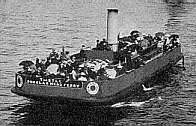Douglas Habour Ferries
 Three double-ended
quadruple-screw ferries plied between Victoria Pier and Battery Pier for Douglas
Head. Named the Rose, Thistle and Shamrock - one hestitates to wonder if a putative fourth would
have been named Leek! They replaced earlier ferries serving the crowds attracted to Douglas Head which had been given
to the town in 1870 by Sir Goldie Taubman of the Nunnery. The Head originally visited for its views, had by the 1890s,
attracted a large assortment of attractions including the camera obscura and a revolving tower as well as the usual pierrot
shows.
Three double-ended
quadruple-screw ferries plied between Victoria Pier and Battery Pier for Douglas
Head. Named the Rose, Thistle and Shamrock - one hestitates to wonder if a putative fourth would
have been named Leek! They replaced earlier ferries serving the crowds attracted to Douglas Head which had been given
to the town in 1870 by Sir Goldie Taubman of the Nunnery. The Head originally visited for its views, had by the 1890s,
attracted a large assortment of attractions including the camera obscura and a revolving tower as well as the usual pierrot
shows.
The service started c.1898 with the formation of the Douglas Steam
Ferry Company, the fare was originally 1d but had increased to 3d by
the 1920s. The ferries were first owned by Laurence Boni and then by
Mr R. Knox.
The ferries were initially moved to Castletown at the start of WW2 but were then transferred to Belfast Lough to be used
as training in the use of landing craft and simulated beach landings. When returned to Castletown the ferries were just
about serviceable - the Thistle re-entering service after extensive repairs in 1948 and Rose, after a season
as a landing stage at Battery Pier, re-entered service in 1949. Shamrock was used to provide spares. The service
closed in 1950 when the Thistle was sold to Pembrokeshire County Council for use as a ferry - she however sank on
her voyage to Milford Haven. The Douglas Steam Ferry Company was liquidated at the end of 1950.
Rose, sold to a new company, was re-engined with a diesel in 1951 and operated a ferry service until the late 1950s
when tourism finally gave out.
Taken from a pre WW1 Ward Lock guide:
The most popular approach to "the Head" is by the steam
ferry (3d.) from Victoria Pier across the Harbour to the Battery
Pier. Though these tubby vessels form quite a small fleet, and
cross every few minutes, they are on fine summer mornings quite
inadequate for the conveyance of the waiting crowds. Numerous
rowing-boats likewise ply to and fro, while people stand from four
to six deep on all the landing-steps eagerly waiting their turn.
The stalwarts who row these deeply-freighted' boats certainly earn
their pence. From the Battery Pier a winding path and many steps
lead up above Port Skillion to the summit.
A feature of these boats was the 'on-board' entertainment provided
by various musicians, even including a pianist, with the passengers
joining in the choruses.
References
Kniveton G.N. et al Douglas Centenary 1896-1996 Douglas:
The Manx Experience 1996 covers development of Douglas Head and the
history of the steam ferries (pp143/4)
 Three double-ended
quadruple-screw ferries plied between Victoria Pier and Battery Pier for Douglas
Head. Named the Rose, Thistle and Shamrock - one hestitates to wonder if a putative fourth would
have been named Leek! They replaced earlier ferries serving the crowds attracted to Douglas Head which had been given
to the town in 1870 by Sir Goldie Taubman of the Nunnery. The Head originally visited for its views, had by the 1890s,
attracted a large assortment of attractions including the camera obscura and a revolving tower as well as the usual pierrot
shows.
Three double-ended
quadruple-screw ferries plied between Victoria Pier and Battery Pier for Douglas
Head. Named the Rose, Thistle and Shamrock - one hestitates to wonder if a putative fourth would
have been named Leek! They replaced earlier ferries serving the crowds attracted to Douglas Head which had been given
to the town in 1870 by Sir Goldie Taubman of the Nunnery. The Head originally visited for its views, had by the 1890s,
attracted a large assortment of attractions including the camera obscura and a revolving tower as well as the usual pierrot
shows.